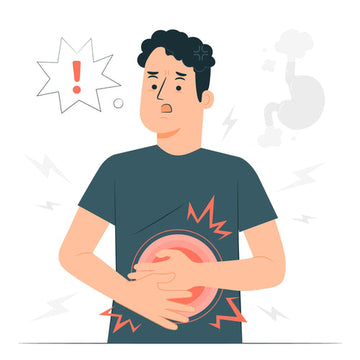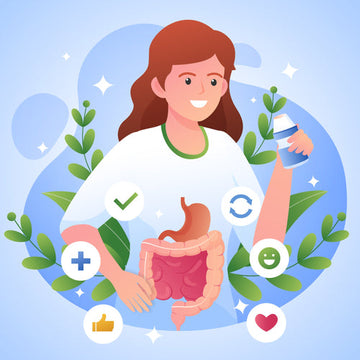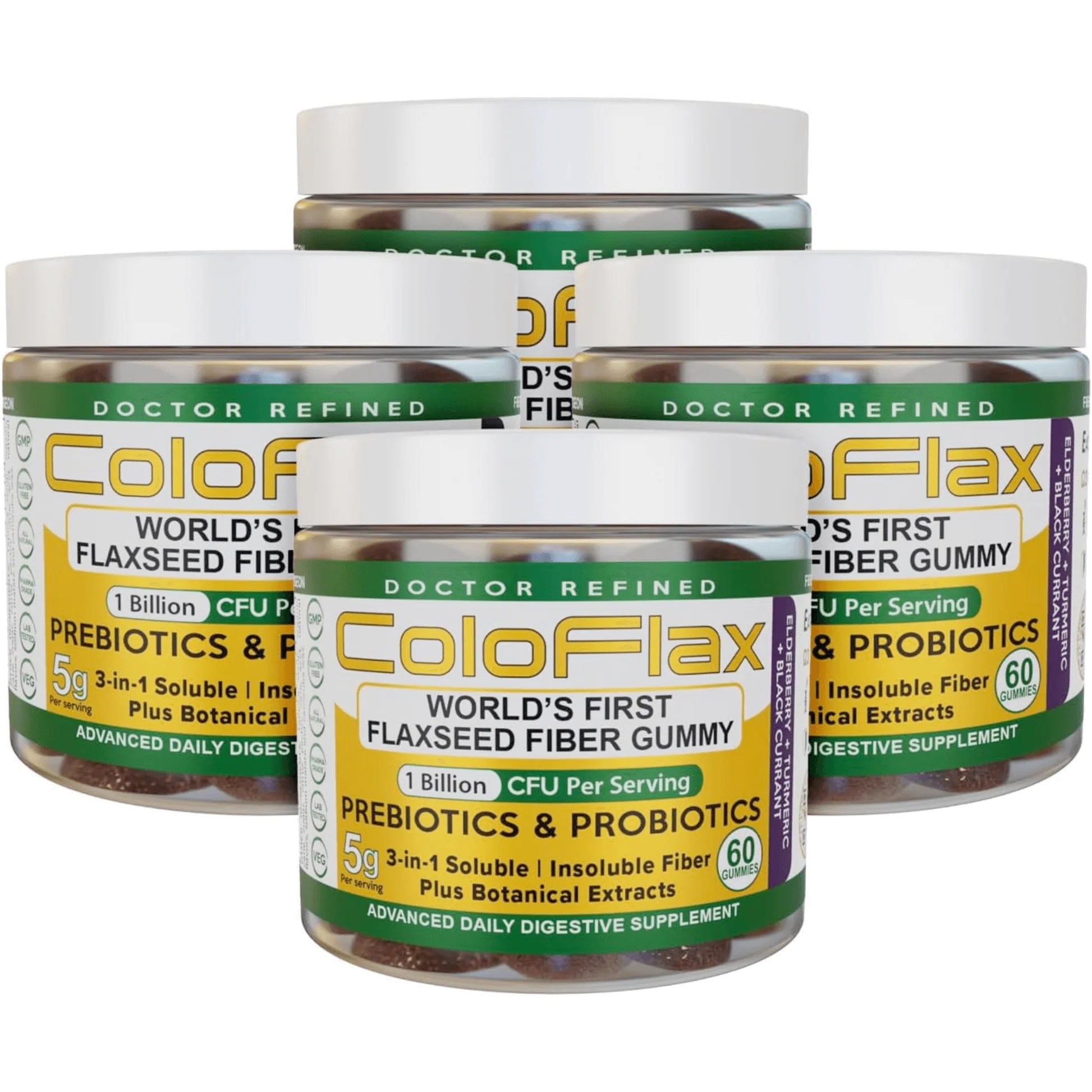Omega-3 fatty acids are never too far from the news cycle. It seems that every month there’s a new story hyping up their benefits and claiming that they can help with everything from heart and digestive health to memory problems and more.
And unlike countless other so-called “superfoods” that don’t deserve their place in the spotlight, omega-3s really are as healthy as claimed.
We’ve mentioned them on several previous occasions, including in our guide to omega-3 fatty acids.
But what about the foods that contain these magical compounds? What are the best sources for meat eaters, vegetarians, and vegans?
Let’s find out.
The Best Sources of Omega-3 Fatty Acids
Obviously, you can get your fill of omega-3 fatty acids from supplements. Fish oil, flaxseed, and other supplements contain enough omega-3s to meet the recommended DV (and then some). You will even find these healthy fats in our ColoFlax flaxseed fiber gummy, along with probiotics, prebiotics, fiber, vitamins, and minerals.
But if you really want to reap the benefits of omega-3 fatty acids, you should get them through food.
Eating several portions of fish a week is one of the best ways to consume omega-3 fatty acids. Fish is abundant in oily fish and can be found in many species, as well. But seeds are also a good source, as are several other plant-based foods.

Before we look more closely at the foods with the highest omega-3 content, let’s see how a number of different foodstuffs compare:
|
Food |
Serving Size |
Omega-3 Content |
DV Percentage* |
|
Chia Seeds |
1 oz |
5,050mg |
2,020% |
|
Mackerel |
3.5 oz |
4,580mg |
1832% |
|
Farmed Salmon |
2 oz |
4,504mg |
1,801.6% |
|
Walnuts |
1 oz |
2,570mg |
1,028% |
|
Cod Liver Oil |
1 Tablespoon |
2,438mg |
975.2% |
|
Flaxseed |
1 Tablespoon |
2,350mg |
940% |
|
Herring |
3.5 oz |
2,150mg |
860% |
|
Wild Salmon |
6 oz |
1,774mg |
709.6% |
|
Anchovy |
2 oz |
1,200mg |
480% |
|
Caviar |
1 Tablespoon |
1,046mg |
418.40% |
|
Swordfish |
3.7 oz |
868mg |
347.2% |
|
Halibut |
5.6 oz |
740mg |
296% |
|
Albacore Tuna |
3 0z |
733mg |
293.2% |
|
Soybeans |
3.5 oz |
670mg |
268% |
|
Mussels |
3 oz |
665mg |
266% |
|
Oysters |
3 oz |
585mg |
234% |
|
Trout |
2.2 oz |
581mg |
232.39% |
|
Sardines |
2 oz |
556mg |
222.40% |
|
Crab |
3 oz |
351mg |
140.39% |
|
Scallops |
3 oz |
310mg |
124% |
|
Atlantic Cod |
6.3 oz |
284mg |
113.6% |
|
Alaskan Pollock |
2.1 oz |
281mg |
112.4% |
|
Shrimp |
3 oz |
267mg |
106.80% |
|
Farmed Catfish |
5oz |
253mg |
101.2% |
|
Clams |
3 oz |
241mg |
96.39% |
|
Light, Skipjack Tuna |
3 oz |
228mg |
91.2% |
|
Mahi Mahi |
5.6 oz |
221mg |
88.4% |
|
Frozen Fish Sticks |
3.2 oz |
193mg |
77.2% |
|
Lobster |
3 oz |
71mg |
28.4% |
*There is no official DV for omega-3 consumption, but most experts recommend 250mg to 500mg a day. These values are based on the lower end of that recommendation.

What about Omega-6?
Αs well as ensuring you get enough omega-3, you also need to make sure you maintain a good ratio of omega-3 and omega-6.
It has been estimated that the modern American diet has a ratio of between 10:1 and 30:1, which equates to between 10mg and 30mg of omega-6 for every 1mg of omega-3. The optimal amount is around 4:1.
Omega-6 is more abundant than omega-3. It is found in many oils and commonly consumed foods, such as peanut butter.
You still need to eat this essential fatty acid, and it is still good for you. Just make sure you keep an eye on those ratios.
|
Food |
Omega-6 Per 3.5oz (100g) |
|
Walnuts |
38,100mg |
|
Sunflower Seeds |
37,400mg |
|
Hemp Seeds |
27,500mg |
|
Safflower Oil |
12,700mg |
|
Avocado Oil |
12,530mg |
|
Almonds |
12,320mg |
|
Peanut Butter |
12,300mg |
|
Cashews |
7,780mg |
|
Tofu |
4,970mg |
|
Eggs |
1,188mg |
Foods with the Highest Omega-3 Content
You’ve seen the list, and we’ve covered the basics, but there’s more to a good quality omega-3 food than milligrams and serving sizes.
Let’s take a closer look at some of the best omega-3 foods.

Mackerel
Mackerel are small, oily fish that are seriously undervalued in many parts of the world. Some cultures have dismissed them as being “unclean” due to the belief that they feed on the corpses of other fish, like vultures of the sea.
There were also spoilage issues in the past, and this led to many reports of mackerel being rotten. In fact, the Cambridge Economic History of Europe notes that English literature contains more references to spoiled and “stinking” mackerel than any other fish.
But if they are eaten fresh or properly preserved, there’s absolutely nothing wrong with mackerel. They are delicious and packed with healthy fats. In addition to the incredibly high omega-3 content (a mixture of EPA and DHA), mackerel contains a massive dose of vitamin B12, vitamin D, and selenium, along with protein.

Chia Seeds
Chia seeds are incredible little things. They are one of the best plant-based sources of omega-3 (in the form of ALA) and also contain high amounts of fiber, along with nutrients like copper, iron, selenium, magnesium, calcium, and manganese. They contain antioxidants as well.
One of the benefits of chia seeds is that they thicken in water and form a fibrous plug. When consumed as part of a healthy breakfast, for instance, they will be digested slowly, keeping you full until lunchtime and providing a steady release of energy.
They’re also cheap and versatile, so there’s really no excuse not to have a pack or two in your pantry.

Salmon
Who doesn’t love salmon? It can be enjoyed baked, grilled, boiled, or smoked and makes for a healthy, high-protein meal. In fact, half a fillet of salmon (around 400 calories) contains close to 40 grams of protein while a small serving of just 200 calories contains 20 grams.
Salmon is not as high in omega-3 fatty acids as mackerel, but it’s still very high and a few weekly servings of farmed or wild salmon will ensure you meet your targets. Try eating a few slices of smoked salmon for breakfast or purchase some fresh or frozen fillets for lunch.

Walnuts
When you think of foods that are high in omega-3 fatty acids, your mind probably jumps to fish and seeds, but some nuts are also a great source. Walnuts are the best example, as they contain a high amount of ALA.
You’ll also get a hefty dose of copper, vitamin E, and manganese, nutrients that aren’t readily available in oily fish.

Sardines
Sardines, like mackerel, are small and oily fish that are packed with healthy fats and make for a fantastic meal or snack. They’re often canned, so you’ll need to check the calories and sodium content, but as the occasional healthy snack, you really can’t go wrong.
In addition to omega-3 fatty acids, sardines are high in vitamin D, selenium, and vitamin B12.
If the sardines have been packed with olive oil, you can eat that as well. Olive oil is very good for you and contains a number of nutrients, including healthy fats.

Flaxseeds
Flaxseeds are a personal favorite of ours, which is why they are included in our flaxseed fiber gummy. They are a healthy foodstuff that has featured prominently in the human diet for thousands of years. We have neglected them somewhat in recent years though, and that’s a huge shame.
Flaxseeds are high in fiber, protein, vitamins, minerals, and antioxidants, as well as omega-3 and omega-6 fatty acids. They are a balanced food source that is very easy to add to your diet.
The easiest way to reap the benefits of flaxseeds is to consume our flaxseed fiber gummy. You can also pick up some whole or ground seeds and add them to everything from salads to oatmeal and smoothies. Unlike many other superfoods (we’re looking at you spirulina), flaxseeds don’t have an off-putting taste that you need to mask. They are mild, nutty, and delicious!

Cod Liver Oil
The Vikings were huge fans of cod liver oil and consumed large quantities during the winter months, ensuring they got plenty of calories, fat, and vitamin D when supplies were low. We take it for much the same reason, although you don’t need to wait for winter to start reaching for those capsules.
Of course, cod liver oil is more of a supplement than a food, but it’s natural and it’s ideal if you’re looking for a simple, clean, whole-food source of omega-3 fatty acids that will ensure you meet your DV in a single dose.

Herring
Herring is another type of small and oily fish. In parts of northern Europe, it’s served smoked as a breakfast food. In the United Kingdom, for instance, they call smoked herring “kippers” and eat them in a dish called “kedgeree”. It’s basically rice, eggs, butter/cream, and flaked kippers. It’s high in healthy fats, protein, and carbs and is a great way to start the day.
Elsewhere, herring is tinned and preserved and can be enjoyed as a snack.

Anchovies
Anchovies are pretty divisive fish. You either hate them with a passion or love them so much that you’re happy to put them on pizza and eat them straight out of the tin. Either way, it’s hard to ignore the incredible nutrient profile of these tiny fish.
They are a fantastic source of healthy fats (including EPA and DHA), as well as calcium, selenium, and niacin. Lovers of oily fish should definitely keep a few tins of anchovies in their pantry. If you’re not a fan, however, they may be too strong for you and it’s best to stick with milder alternatives.

Soybeans
Soybeans don’t have the highest concentration of omega-3 fatty acids, but a single serving will still give you more than your DV. More importantly, they are very high in plant-based protein and are a great alternative to fish for vegetarians and vegans.
Soybeans are a source of many vitamins and minerals, including potassium, magnesium, vitamin K, folate, and riboflavin.
The only downside is that they contain high levels of omega-6 fatty acids, so it’s best not to rely entirely on soybeans to meet your omega-3 targets
Summary: Omega-3 Sources
Whether you’re eating fish, seeds, or a mixture of both, it’s important to get plenty of omega-3 and ensure you maintain a good ratio of omega-3 and 6. And remember, it’s not all about omega-3.
If you’re eating lots of fatty fish, for example, you should think about how much total fat you’re consuming and whether you’re exceeding your recommended intake of sodium (a problem with preserved fish). Pregnant women, young children, and those who consume large quantities of fish should also consider the mercury content of seafood.
If you’re getting your omega-3s from plant-based sources, you won’t have the same concerns, but it’s still important to monitor your calories and eat a balanced diet to meet other nutrient targets.






